Abstract
This analysis draws upon data from the Organization for Economic Cooperation and Development and other cross-national analyses to compare health care spending, supply, utilization, prices, and health outcomes across 13 high-income countries: Australia, Canada, Denmark, France, Germany, Japan, Netherlands, New Zealand, Norway, Sweden, Switzerland, the United Kingdom, and the United States. These data predate the major insurance provisions of the Affordable Care Act. In 2013, the U.S. spent far more on health care than these other countries. Higher spending appeared to be largely driven by greater use of medical technology and higher health care prices, rather than more frequent doctor visits or hospital admissions. In contrast, U.S. spending on social services made up a relatively small share of the economy relative to other countries. Despite spending more on health care, Americans had poor health outcomes, including shorter life expectancy and greater prevalence of chronic conditions.
OVERVIEW
Cross-national comparisons allow us to track the performance of the U.S. health care system, highlight areas of strength and weakness, and identify factors that may impede or accelerate improvement. This analysis is the latest in a series of Commonwealth Fund cross-national comparisons that use health data from the Organization for Economic Cooperation and Development (OECD), as well as from other sources, to assess U.S. health care system spending, supply, utilization, and prices relative to other countries, as well as a limited set of health outcomes.1,2 Thirteen high-income countries are included: Australia, Canada, Denmark, France, Germany, Japan, Netherlands, New Zealand, Norway, Sweden, Switzerland, the United Kingdom, and the United States. On measures where data are widely available, the value for the median OECD country is also shown. Almost all data are for years prior to the major insurance provisions of the Affordable Care Act; most are for 2013.
Health care spending in the U.S. far exceeds that of other high-income countries, though spending growth has slowed in the U.S. and in most other countries in recent years.3 Even though the U.S. is the only country without a publicly financed universal health system, it still spends more public dollars on health care than all but two of the other countries. Americans have relatively few hospital admissions and physician visits, but are greater users of expensive technologies like magnetic resonance imaging (MRI) machines. Available cross-national pricing data suggest that prices for health care are notably higher in the U.S., potentially explaining a large part of the higher health spending. In contrast, the U.S. devotes a relatively small share of its economy to social services, such as housing assistance, employment programs, disability benefits, and food security.4 Finally, despite its heavy investment in health care, the U.S. sees poorer results on several key health outcome measures such as life expectancy and the prevalence of chronic conditions. Mortality rates from cancer are low and have fallen more quickly in the U.S. than in other countries, but the reverse is true for mortality from ischemic heart disease.
|
The Commonwealth Fund has supported a series of publications using OECD Health Data since 1998 |
KEY FINDINGS
The United States is the highest spender on health care. [Exhibits 1, 2]
Data from the OECD show that the U.S. spent 17.1 percent of its gross domestic product (GDP) on health care in 2013. This was almost 50 percent more than the next-highest spender (France, 11.6% of GDP) and almost double what was spent in the U.K. (8.8%). U.S. spending per person was equivalent to $9,086 (not adjusted for inflation).
Since 2009, health care spending growth has slowed in the U.S. and most other countries. The real growth rate per capita in the U.S. declined from 2.47 percent between 2003 and 2009 to 1.50 percent between 2009 and 2013. In Denmark and the United Kingdom, the growth rate actually became negative. The timing and cross-national nature of the slowdown suggest a connection to the 2007–2009 global financial crisis and its aftereffects, though additional factors also may be at play.5
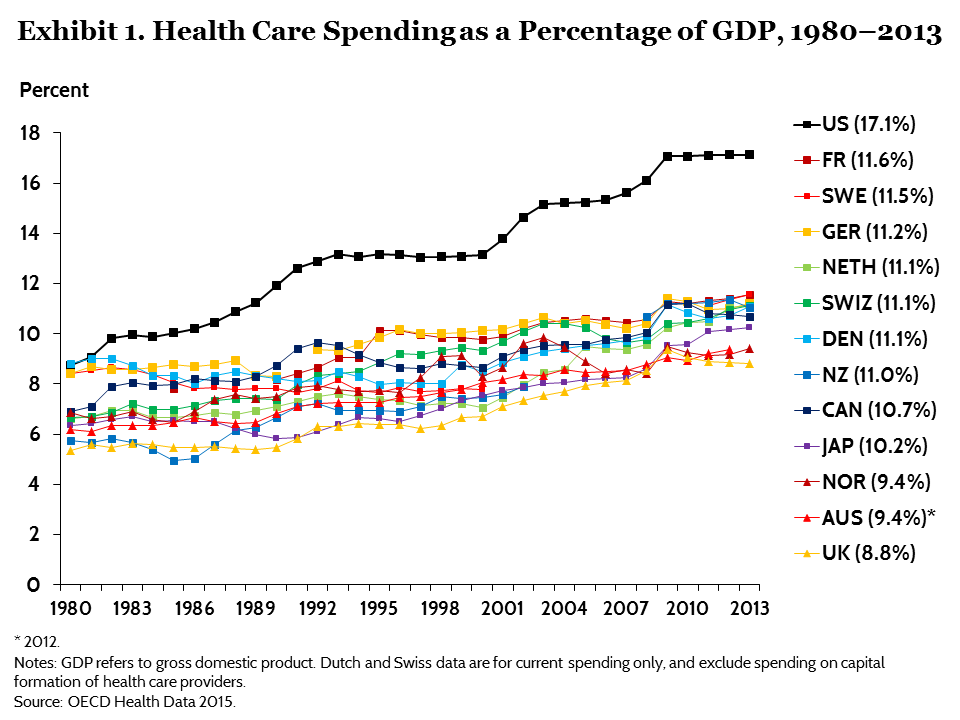
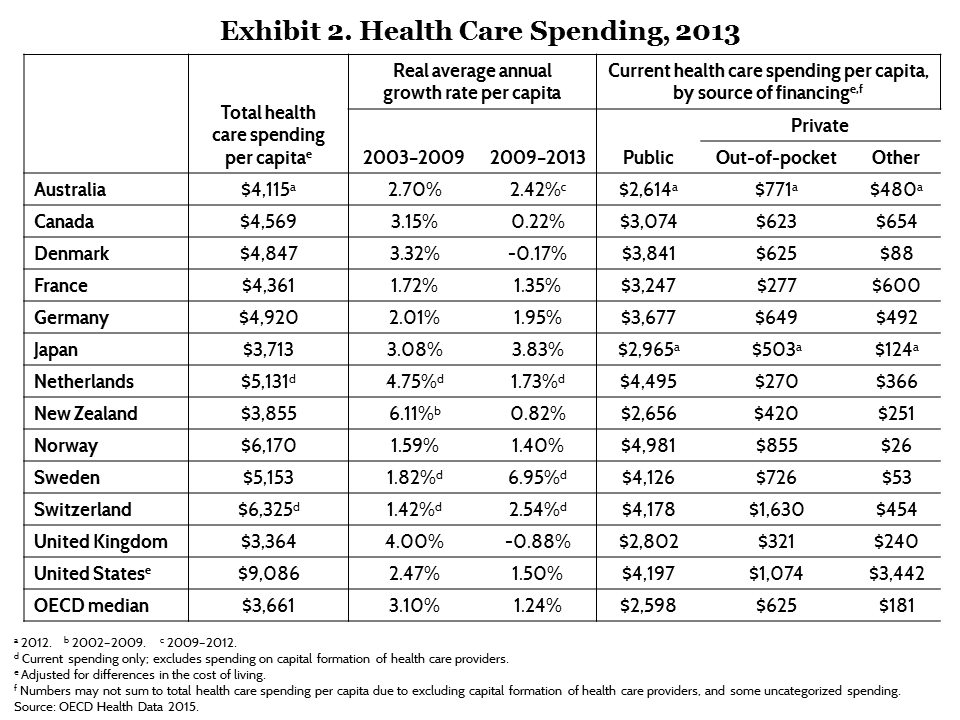
Download these charts in ChartCart
Private spending on health care is highest in the U.S. [Exhibit 2]
In 2013, the average U.S. resident spent $1,074 out-of-pocket on health care, for things like copayments for doctor’s office visits and prescription drugs and health insurance deductibles. Only the Swiss spent more at $1,630, while France and the Netherlands spent less than one-fourth as much ($277 and $270, respectively). As for other private health spending, including on private insurance premiums, U.S. spending towered over that of the other countries at $3,442 per capita—more than five times what was spent in Canada ($654), the second-highest spending country.6
U.S. public spending on health care is high, despite covering fewer residents. [Exhibit 2]
Public spending on health care amounted to $4,197 per capita in the U.S. in 2013, more than in any other country except Norway ($4,981) and the Netherlands ($4,495), despite the fact that the U.S. was the only country studied that did not have a universal health care system. In the U.S., about 34 percent of residents were covered by public programs in 2013, including Medicare and Medicaid.7 By comparison, every resident in the United Kingdom is covered by the public system and spending was $2,802 per capita. Public spending on health care would be even greater in the U.S. if the tax exclusion for employer-sponsored health insurance (amounting to about $250 billion each year) was counted as a public expenditure.8
Despite spending more on health care, Americans have fewer hospital and physician visits. [Exhibit 3, 4]
The U.S. had fewer practicing physicians in 2013 than in the median OECD country (2.6 versus 3.2 physicians per 1,000 population). With only four per year, Americans also had fewer physician visits than the OECD median (6.5 visits). In contrast, the average Canadian had 7.7 physician visits and the average Japanese resident had 12.9 visits in 2012.
In the U.S., there were also fewer hospital beds and fewer discharges per capita than in the median OECD country.
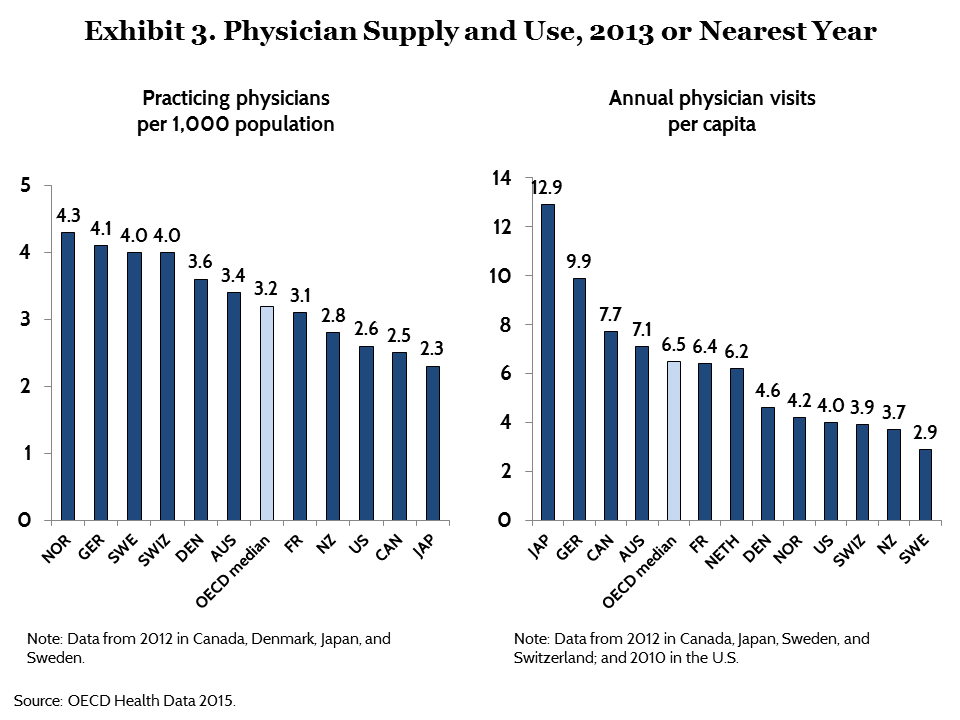
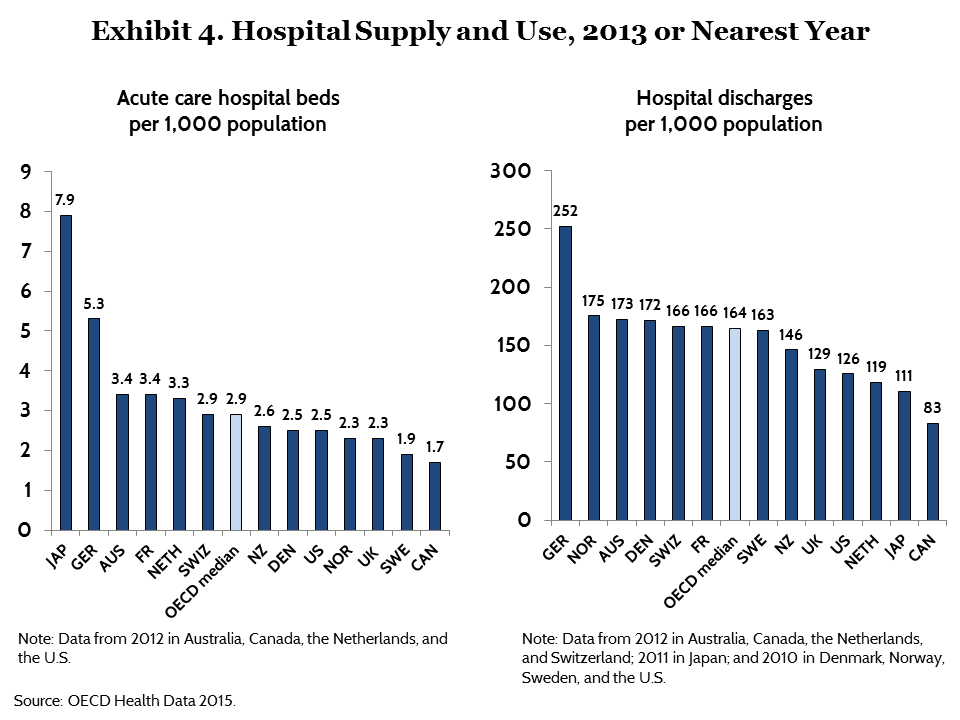
Americans appear to be greater consumers of medical technology, including diagnostic imaging and pharmaceuticals. [Exhibit 5, 6]
The U.S. stood out as a top consumer of sophisticated diagnostic imaging technology. Americans had the highest per capita rates of MRI, computed tomography (CT), and positron emission tomography (PET) exams among the countries where data were available. The U.S. and Japan were among the countries with the highest number of these imaging machines.9
In addition, Americans were top consumers of prescription drugs. Based on findings from the 2013 Commonwealth Fund International Surveys, adults in the U.S. and New Zealand on average take more prescription drugs (2.2 per adult) than adults in other countries.

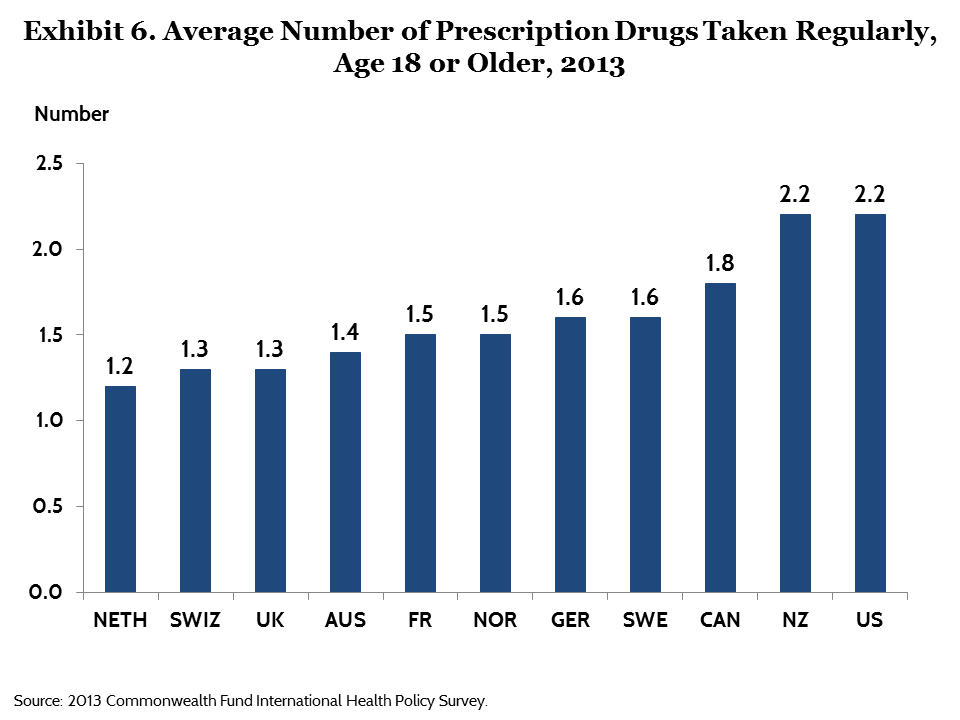
Health care prices are higher in the U.S. compared with other countries. [Exhibit 7]
Data published by the International Federation of Health Plans suggest that hospital and physician prices for procedures were highest in the U.S. in 2013.10 The average price of bypass surgery was $75,345 in the U.S. This is more than $30,000 higher than in the second-highest country, Australia, where the procedure costs $42,130. According to the same data source, MRI and CT scans were also most expensive in the U.S. While these pricing data are subject to significant methodological limitations, they illustrate a pattern of significantly higher prices in many areas of U.S. health care.
Other studies have observed high U.S. prices for pharmaceuticals. A 2013 investigation by Kanavos and colleagues created a cross-national price index for a basket of widely used in-patent pharmaceuticals. In 2010, all countries studied had lower prices than the U.S. In Australia, Canada, and the United Kingdom, prices were about 50 percent lower.11

The U.S. invests the smallest share of its economy on social services. [Exhibit 8]
A 2013 study by Bradley and Taylor found that the U.S. spent the least on social services—such as retirement and disability benefits, employment programs, and supportive housing—among the countries studied in this report, at just 9 percent of GDP.12 Canada, Australia and New Zealand had similarly low rates of spending, while France, Sweden, Switzerland, and Germany devoted roughly twice as large a share of their economy to social services as did the U.S.
The U.S. was also the only country studied where health care spending accounted for a greater share of GDP than social services spending. In aggregate, U.S. health and social services spending rank near the middle of the pack.

Despite its high spending on health care, the U.S. has poor population health. [Exhibit 9]
On several measures of population health, Americans had worse outcomes than their international peers. The U.S. had the lowest life expectancy at birth of the countries studied, at 78.8 years in 2013, compared with the OECD median of 81.2 years. Additionally, the U.S. had the highest infant mortality rate among the countries studied, at 6.1 deaths per 1,000 live births in 2011; the rate in the OECD median country was 3.5 deaths.
The prevalence of chronic diseases also appeared to be higher in the U.S. The 2014 Commonwealth Fund International Health Policy Survey found that 68 percent of U.S. adults age 65 or older had at least two chronic conditions. In other countries, this figure ranged from 33 percent (U.K.) to 56 percent (Canada).13
A 2013 report from the Institute of Medicine reviewed the literature about the health disadvantages of Americans relative to residents of other high-income countries. It found the U.S. performed poorly on several important determinants of health.14 More than a third of adults in the U.S. were obese in 2012, a rate that was about 15 percent higher than the next-highest country, New Zealand. The U.S. had one of the lowest smoking rates in 2013, but one of the highest rates of tobacco consumption in the 1960s and 1970s. This earlier period of heavy tobacco use may still be contributing to relatively worse health outcomes among older U.S. adults.15 Other potential contributors to the United States’ health disadvantage include the large number of uninsured, as well as differences in lifestyle, environment, and rates of accidents and violence.
The Institute of Medicine found that poorer health in the U.S. was not simply the result of economic, social, or racial and ethnic disadvantages—even well-off, nonsmoking, nonobese Americans appear in worse health than their counterparts abroad.
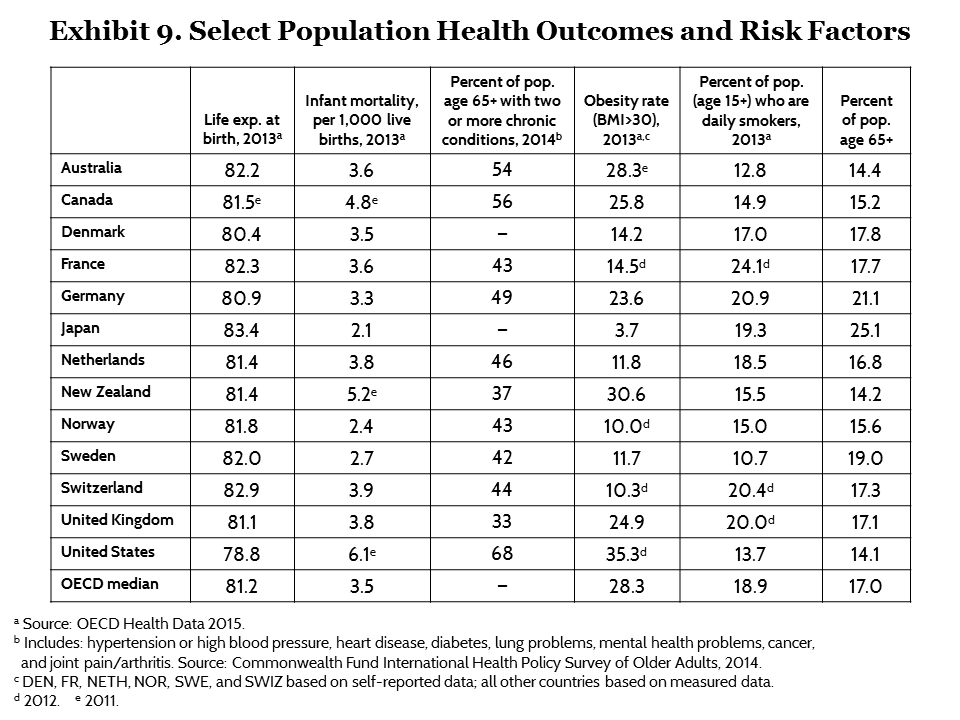
The U.S. performs well on cancer care but has high rates of mortality from heart disease and amputations as a result of diabetes. [Exhibits 10, 11, 12]
One area where the U.S. appeared to have comparatively good health outcomes was cancer care. A 2015 study by Stevens et al. found that mortality rates from cancer in the U.S. were lower and had declined faster between 1995 and 2007 than in most industrialized countries.16 Other research based on survival rates also suggests that U.S. cancer care is above average, though these studies are disputed on methodological grounds.17
The opposite trend appears for ischemic heart disease, where the U.S. had among the highest mortality rates in 2013—128 per 100,000 population compared with 95 in the median OECD country. Since 1995, mortality rates have fallen significantly in all countries as a result of improved treatment and changes in risk factors.18 However, this decline was less pronounced in the U.S., where rates declined from 225 to 128 deaths per 100,000 population—considerably less than countries like Denmark, where rates declined from 242 to 71 deaths per 100,000 population.
The U.S. also had high rates of adverse outcomes from diabetes, with 17.1 lower extremity amputations per 100,000 population in 2011. Rates in Sweden, Australia and the U.K. were less than one-third as high.
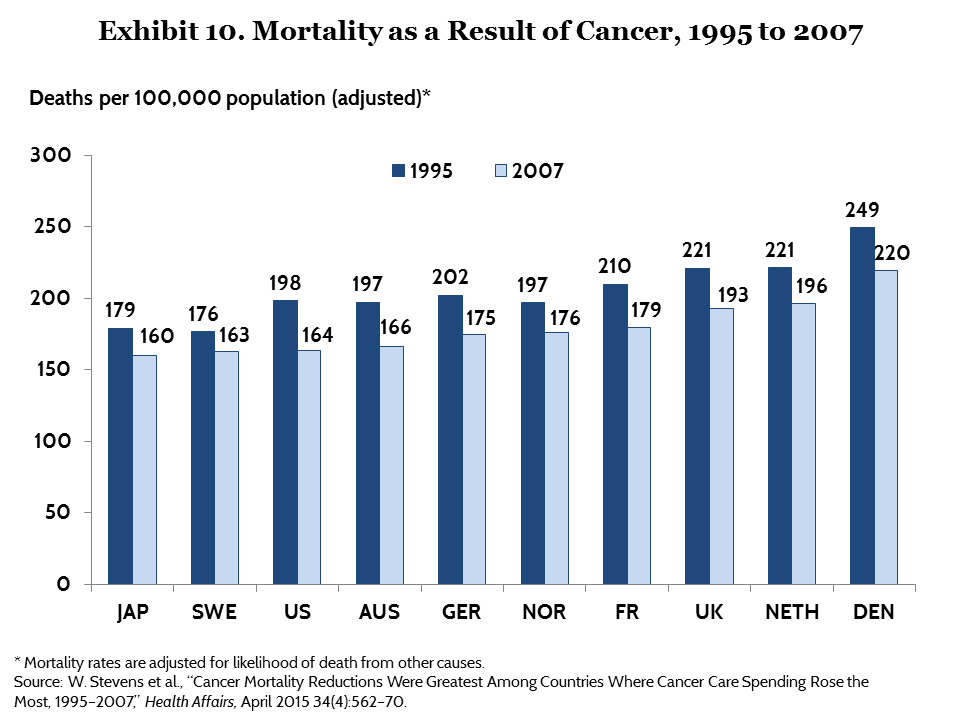
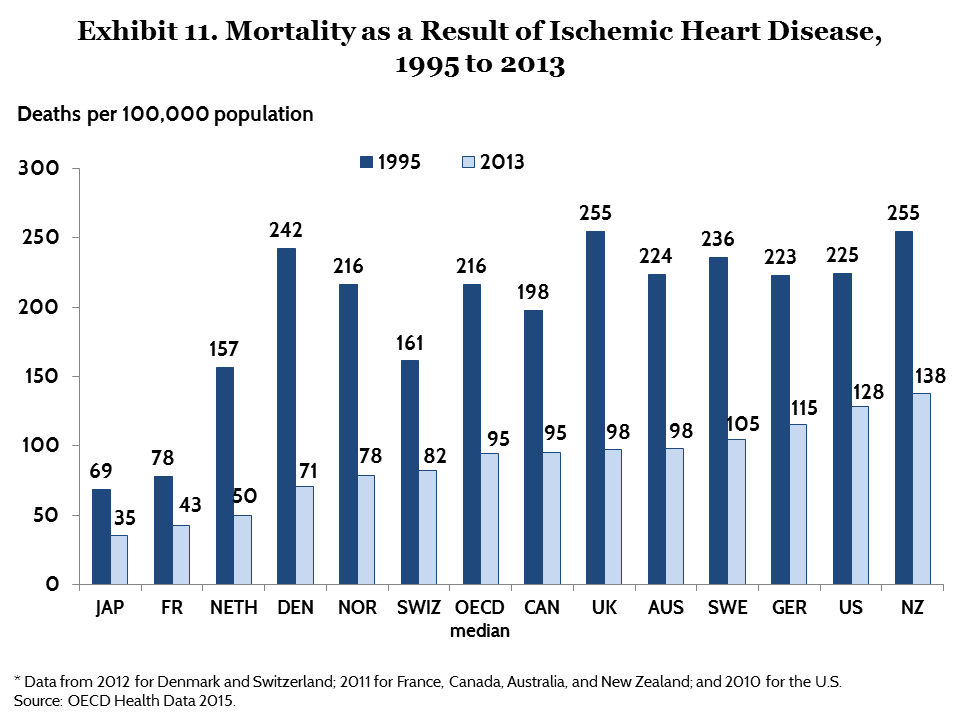

DISCUSSION
Health care spending in the U.S. far exceeds that in other countries, despite a global slowdown in spending growth in recent years. At 17.1 percent of GDP, the U.S. devotes at least 50 percent more of its economy to health care than do other countries. Even public spending on health care, on a per capita basis, is higher in the U.S. than in most other countries with universal public coverage.
How can we explain the higher U.S. spending? In line with previous studies,19 the results of this analysis suggest that the excess is likely driven by greater utilization of medical technology and higher prices, rather than use of routine services, such as more frequent visits to physicians and hospitals.
High health care spending has far-reaching consequences in the U.S. economy, contributing to wage stagnation, personal bankruptcy, and budget deficits, and creating a competitive disadvantage relative to other nations.20 One potential consequence of high health spending is that it may crowd out other forms of social spending that support health. In the U.S., health care spending substantially outweighs spending on social services. This imbalance may contribute to the country’s poor health outcomes. A growing body of evidence suggests that social services play an important role in shaping health trajectories and mitigating health disparities.21,22 Additional cross-national research is needed to better understand the relationship between social services and health, as well as other health determinants like lifestyle and environment.
New care models that reward health care providers based on their patient population’s health outcomes (e.g., accountable care organizations) are an interesting development. Such accountability could create a business case for health care providers to invest in certain social services or other nonclinical interventions, if doing so would be a cost-effective way to improve patients’ health.23 Over the long term, such a strategy could potentially alter the current balance between health and social services spending.
|
METHODS |
Notes
1 D. Squires, “The Global Slowdown in Health Care Spending,” Journal of the American Medical Association, Aug. 6, 2014 312(5):485–86; D. Squires, Explaining High Health Care Spending in the United States: An International Comparison of Supply, Utilization, Prices, and Quality (New York: The Commonwealth Fund, May 2012); D. Squires, The U.S. Health System in Perspective: A Comparison of Twelve Industrialized Nations (New York: The Commonwealth Fund, July 2011); G. F. Anderson and D. Squires, Measuring the U.S. Health Care System: A Cross-National Comparison (New York: The Commonwealth Fund, June 2010); G. F. Anderson and B. K. Frogner, “Health Spending in OECD Countries: Obtaining Value per Dollar,” Health Affairs, Nov./Dec. 2008 27(6):1718–27; G. F. Anderson, B. K. Frogner, and U. E. Reinhardt, “Health Spending in OECD Countries in 2004: An Update,” Health Affairs, Sept./Oct. 2007 26(5):1481–89; G. F. Anderson, P. S. Hussey, B. K. Frogner et al., “Health Spending in the United States and the Rest of the Industrialized World,” Health Affairs, July/Aug. 2005 24(4):903–14; U. E. Reinhardt, P. S. Hussey, and G. F. Anderson, “U.S. Health Care Spending in an International Context,” Health Affairs, May/June 2004 23(3):10–25; G. F. Anderson, U. E. Reinhardt, P. S. Hussey et al., “It’s the Prices, Stupid: Why the United States Is So Different from Other Countries,” Health Affairs, May/June 2003, 22(3):89–105; U. E. Reinhardt, P. S. Hussey, and G. F. Anderson, “Cross-National Comparisons of Health Systems Using OECD Data, 1999,” Health Affairs, May/ June 2002 21(3):169–81; G. F. Anderson and P. S. Hussey, “Comparing Health System Performance in OECD Countries,” Health Affairs, May/June 2001 20(3):219–32; G. F. Anderson, J. Hurst, P. S. Hussey et al., “Health Spending and Outcomes: Trends in OECD Countries, 1960–1998,” Health Affairs, May/June 2000 19(3):150–57; and G. F. Anderson and J. P. Poullier, “Health Spending, Access, and Outcomes: Trends in Industrialized Countries,” Health Affairs, May/June 1999 18(3):178–92.
2 Unlike the Fund’s Mirror, Mirror on the Wall series, this report does not attempt to assess overall health system performance, or rank health systems across various metrics. See: K. Davis, K. Stremikis, C. Schoen, and D. Squires, Mirror, Mirror on the Wall, 2014 Update: How the U.S. Health Care System Compares Internationally (New York: The Commonwealth Fund, June 2014).
3 Organization for Economic Cooperation and Development, OECD Health Data 2015 (Paris: OECD, June 2015).
4 E. H. Bradley and L. A. Taylor, The American Health Care Paradox: Why Spending More Is Getting Us Less (New York: Public Affairs, 2013).
5 Squires, “Global Slowdown,” 2014.
6 Because of data limitations in several countries, the breakdown of health spending by source of financing is for current spending only, meaning it excludes capital formation of health care providers. In most countries, those amounts range between 2 percent and 7 percent of total health spending.
7 U.S. Census Bureau, Health Insurance in the United States: 2013—Tables & Figures, 2014.
8 Congressional Budget Office, Options for Reducing The Deficit: 2014 to 2023 (Washington, D.C.: CBO, Nov. 2013).
9 It should be noted that, despite the comparatively high levels of use in the U.S., growth in medical imaging appears to have leveled off in recent years after surging through much of the 2000s. The slowdown has been attributed to patient cost-sharing, prior authorization, best-practice guidelines, and other strategies to reduce potentially unnecessary utilization. See D. W. Lee and F. Levy, “The Sharp Slowdown in Growth of Medical Imaging: An Early Analysis Suggests Combination of Policies Was the Cause,” Health Affairs, Aug. 2012 31(8):1876–84.
10 International Federation of Health Plans, 2013 Comparative Price Report.
11 P. Kanavos, A. Ferrario, S. Vandoros et al., “Higher U.S. Branded Drug Prices and Spending Compared to Other Countries May Stem Partly from Quick Uptake of New Drugs,” Health Affairs, April 2013 32(4):753–61.
12 Bradley and Taylor, American Health Care Paradox, 2013.
13 Chronic conditions included hypertension or high blood pressure, heart disease, diabetes, lung problems, mental health problems, cancer, and joint pain/arthritis. See Commonwealth Fund 2014 International Health Policy Survey of Older Adults.
14 J. D. Freeman, S. Kadiyala, J. F. Bell et al., “The Causal Effect of Health Insurance on Utilization and Outcomes in Adults: A Systematic Review of US Studies,” Medical Care, 2008 46(10):1023–32; and S. H. Woolf and L. Aron (eds.), U.S. Health in International Perspective: Shorter Lives, Poorer Health (Washington, D.C.: National Academies Press, 2013).
15 Woolf and Aron (eds.), U.S. Health in International Perspective, 2013.
16 W. Stevens, T. J. Philipson, Z. M. Khan et al., “Cancer Mortality Reductions Were Greatest Among Countries Where Cancer Care Spending Rose the Most, 1995–2007,” Health Affairs, April 2015 34(4):562–70.
17 T. Philipson, M. Eber, D. N. Lakdawalla et al., “An Analysis of Whether Higher Health Care Spending in the United States Versus Europe Is ‘Worth It’ in the Case of Cancer,” Health Affairs, April 2012 31(4):667–75; S. Soneji and J. Yang, “New Analysis Reexamines the Value of Cancer Care in the United States Compared to Western Europe,” Health Affairs, March 2015 34(3):390–97; D. Goldman, D. Lakdawalla, and T. Philipson, “Mortality Versus Survival in International Comparisons of Cancer Care,” Health Affairs Blog, March 20, 2015; and H. G. Welch and E. Fisher, “Revisiting Mortality Versus Survival in International Comparisons of Cancer Care,” Health Affairs Blog, April 1, 2015.
18 Organization for Economic Cooperation and Development, Cardiovascular Disease and Diabetes: Policies for Better Health and Quality of Care (Paris: OECD, June 2015).
19 Squires, Explaining High Health Care Spending, 2012; Anderson, Frogner, and Reinhardt, “Health Spending in OECD Countries,” 2007; M. J. Laugesen and S. A. Glied, “Higher Fees Paid to U.S. Physicians Drive Higher Spending for Physician Services Compared to Other Countries,” Health Affairs, Sept. 2011 30(9):1647–56.
20 D. I. Auerbach and A. L. Kellermann, “A Decade of Health Care Cost Growth Has Wiped Out Real Income Gains for an Average U.S. Family,” Health Affairs, Sept. 2011 30(9):1630–36; D. Blumenthal and D. Squires, “Do Health Care Costs Fuel Economic Inequality in the United States?” The Commonwealth Fund Blog, Sept. 9, 2014; D. U. Himmelstein, D. Thorne, E. Warren et al., “Medical Bankruptcy in the United States, 2007: Results of a National Study,” American Journal of Medicine, Aug. 2009 122(8):741–46; RAND Health, How Does Growth in Health Care Costs Affect the American Family? (Santa Monica, Calif.: RAND, 2011); and T. Johnson, Healthcare Costs and U.S. Competitiveness (New York: Council on Foreign Relations, March 2012).
21 M. Avendano and I. Kawachi, “Why Do Americans Have Shorter Life Expectancy and Worse Health Than Do People in Other High-Income Countries?” Annual Review of Public Health, March 2014 35:307–25; and Bradley and Taylor, American Health Care Paradox, 2013.
22 E. H. Bradley, B. R. Elkins, J. Herrin et al., “Health and Social Services Expenditures: Associations with Health Outcomes,” BMJ Quality & Safety, published online March 29, 2011.
23 D. Bachrach, H. Pfister, K. Wallis et al., Addressing Patients’ Social Needs: An Emerging Business Case for Provider Investment (New York: The Commonwealth Fund, May 2014).
